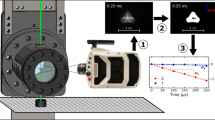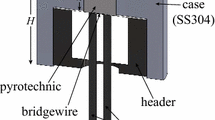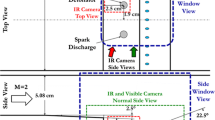Abstract
Homogeneous and inhomogeneous ignition of real and surrogate fuels were imaged in two Stanford shock tubes, revealing the influence of small particle fragmentation. n-Heptane, iso-octane, and Jet A were studied, each mixed in an oxidizer containing 21% oxygen and ignited at low temperatures (900–1000 K), low pressures (1–2 atm), with an equivalence ratio of 0.5. Visible images (350–1050 nm) were captured through the shock tube endwall using a high-speed camera. Particles were found to arrive near the endwalls of the shock tubes approximately 5 ms after reflection of the incident shock wave. Reflected shock wave experiments using diaphragm materials of Lexan and steel were investigated. Particles collected from the shock tubes after each experiment were found to match the material of the diaphragm burst during the experiment. Following each experiment, the shock tubes were cleaned by scrubbing with cotton cloths soaked with acetone. Particles were observed to fragment after arrival near the endwall, often leading to inhomogeneous ignition of the fuel. Distinctly more particles were observed during experiments using steel diaphragms. In experiments exhibiting inhomogeneous ignition, flames were observed to grow radially until all the fuel within the cross section of the shock tube had been consumed. The influence of diluent gas (argon or helium) was also investigated. The use of He diluent gas was found to suppress the number of particles capable of causing inhomogeneous flames. The use of He thus allowed time history studies of ignition to extend past the test times that would have been limited by inhomogeneous ignition.








Similar content being viewed by others
References
Richards, G.A., McMillian, M.M., Gemmen, R.S., Rogers, W.A., Cully, S.R.: Issues for low-emission, fuel-flexible power systems. Prog. Energy Combust. Sci. 27(2), 141–169 (2001). https://doi.org/10.1016/S0360-1285(00)00019-8
Heufer, K.A., Olivier, H.: Optical investigation of shock induced ignition of different biofuels. In: 23rd Proceedings of the 23rd International Colloquium on the Dynamics of Explosion and Reactive Systems, Paper 163 (2011)
Fieweger, K., Blumenthal, R., Adomeit, G.: Self-ignition of S.I. engine model fuels: a shock tube investigation at high pressure. Combust. Flame 109(4), 599–619 (1997). https://doi.org/10.1016/S0010-2180(97)00049-7
Mansfield, A.B., Wooldridge, M.S.: Low-temperature ignition behavior of iso-octane. Fuel 139(1), 79–86 (2015). https://doi.org/10.1016/j.fuel.2014.08.019
Leschevich, V.V., Martynenko, V.V., Penyazkov, O.G., et al.: Auto-ignitions of a methane/air mixture at high and intermediate temperatures. Shock Waves 26, 657 (2016). https://doi.org/10.1007/s00193-016-0665-9
Davidson, D.F., Tulgestke, A.M., Strand, C., Campbell, M., Troutman, V.A., Miller, V.A., Hanson, R.K.: Rapid chemiluminescent imaging behind reflected shock waves. In: 30th International Symposium on Shock Waves 1. Springer, Cham (2017). https://doi.org/10.1007/978-3-319-46213-4_52
Weber, Y.S., Oran, W.S., Boris, J.P., Anderson, J.D.: The numerical simulation of shock bifurcation near the end wall of a shock tube. Phys. Fluids 7(10), 2475–2488 (1995). https://doi.org/10.1063/1.868691
Grogan, K.P., Ihme, M.: Weak and strong ignition of hydrogen/oxygen mixtures in shock-tube systems. Proc. Combust. Inst. 35(2), 2181–2189 (2015). https://doi.org/10.1016/j.proci.2014.07.074
Elsworth, J.E., Haskell, W.W., Read, I.A.: Non-uniform ignition processes in rapid-compression machines. Combust. Flame 13(4), 437–438 (1969). https://doi.org/10.1016/0010-2180(69)90115-1
Pfahl, U., Fieweger, K., Adomeit, G.: Self-ignition of diesel-relevant hydrocarbon-air mixtures under engine conditions. Symp. (Int.) Combust. 26(1), 781–789 (1996). https://doi.org/10.1016/S0082-0784(96)80287-6
Campbell, M.F., Tulgestke, A.M., Davidson, D.F., Hanson, R.K.: A second-generation constrained reaction volume shock tube. Rev. Sci. Instrum. 85, 5 (2014). https://doi.org/10.1063/1.4875056
Oehlschlaeger, M.A., Davidson, D.F., Hanson, R.K.: High-temperature thermal decomposition of isobutane and \(n\)-butane behind shock waves. J. Phys. Chem. A 108, 4247–4253 (2004). https://doi.org/10.1021/jp0313627
Chen, Z., Burke, M.P., Ju, Y.: On the critical flame radius and minimum ignition energy for spherical flame initiation. Proc. Combust. Inst. 33(1), 1219–1226 (2011). https://doi.org/10.1016/j.proci.2010.05.005
Acknowledgements
This material is based upon work supported by the U.S. Army Research Laboratory and the U.S. Army Research Office under contract/Grant Number W911NF-13-1-0206.
Author information
Authors and Affiliations
Corresponding author
Additional information
Communicated by G. Ciccarelli.
Publisher's Note
Springer Nature remains neutral with regard to jurisdictional claims in published maps and institutional affiliations.
Electronic supplementary material
Below is the link to the electronic supplementary material.
Rights and permissions
About this article
Cite this article
Tulgestke, A.M., Johnson, S.E., Davidson, D.F. et al. High-speed imaging of inhomogeneous ignition in a shock tube. Shock Waves 28, 1089–1095 (2018). https://doi.org/10.1007/s00193-018-0824-2
Received:
Revised:
Accepted:
Published:
Issue Date:
DOI: https://doi.org/10.1007/s00193-018-0824-2




